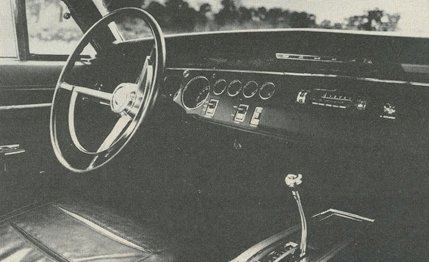Handling was dominated by the Charger’s inherent understeer characteristics, a function of both the massive Hemi engine in the front of the car and the large front anti-sway bar. The understeer tendency was strong enough that once the limit of adhesion was reached and the front end began to plow, only instant full throttle in the lower gears would get the rear end out. A gentle increase in throttle would only increase the amount of understeer. By anticipating breakaway, we could coax the Charger into a 4-wheel slide with a flick of the wheel and a simultaneous increase in throttle. This induced power-slide was fairly easy to control, but it took up a lot of the road. Generally, the Goodyear F70-15 tires gave good performance and allowed fairly fast cornering without breaking traction—the only way to go, on the street; other maneuvers we restricted to the test track. The Charger assumes a fair amount of body lean when cornering, despite the giant anti-sway bar, stiff springs, and heavy-duty shock absorbers—all of which come with the Hemi.
The Hemi Charger’s ride, while harsh by most standards, will be called appropriately firm by most enthusiasts. There will be those who will argue that a Pontiac GTO or an Olds 4-4-2 handles as well without the attendant harshness. But both of these cars suffer from a certain amount of axle hop under hard braking and acceleration, something we didn’t encounter with the Charger. It’s all a question of how hard the rubber bushings are, and, in the case of the Charger, how many leaves the rear springs have. We’d rather suffer a harshness than axle hop, if a common solution to both problems can’t be found. Much of the harshness we felt resulted from the 30 psi tire pressures that are recommended with the Hemi.
While we are discussing handling, we ought to point out that unless your Hemi Charger is going to be used strictly on the drag strip, power steering is a must, not only for its ease of operation—you’ve got to be a weight lifter to park a manual steering Hemi—but also because of the faster steering ratio in the power unit. The manual steering has an overall ratio of 28.8-to-one while the power gear is 18.8-to-one—almost twice as fast.
Our main objections to the Charger were on the inside. The seats are terrible—they just don’t do anything right. Our unhappiness concerned not so much the seat cushions themselves, but the position of the seat in the car and the angle between the seat proper and the seat back. The seat is very low, relative to the steering wheel, and the seat back—not adjustable—seems to be almost perpendicular to the seat cushion, forcing us to sit bolt-upright. The guys who design seats should have to sit in them while they work at their drawing boards.
|
|
We also didn’t like the shift lever in the optional console we ordered. Not only is it ugly and out of place in the context of the rest of the Charger’s interior, but the detent button is directly on top, making for an unnatural motion when shifting manually. Of the levers we’ve seen, the T-handle with the button on the side, like the Cougar and the Mustang, or the “goal-post” shifter used by Buick and Oldsmobile, where one squeezes the crossbar to release the detent, are both excellent. We’d settle for either in place of the Charger’s (which is shared by all Chrysler console shifters).
With the exception of the rear quarters, vision from within the Charger is good, and we aren’t prepared to sacrifice the attractive tunnel-roof wings for visibility. We do, however, recommend a right-hand outside mirror to compensate.
We don’t care for (and didn’t order) optional belt-like stripes around the rear quarters that Dodge is emphasizing this year. Stripes—like fastbacks—are out in any form; matte black anti-glare paint on the hood is in now, and a good design could be worked into the Charger’s hood vent sculpturing.
The Chrysler Corporation is opposed to ventless door windows, on the grounds that there really isn’t a practical flow-through ventilation system. So the Charger still has vent windows, and we suspect that Chrysler might just be right. Time will tell. We were glad to have them on our Charger, because air-conditioning is not available with the Hemi engine—it just won’t fit.
To add frosting to the cake, the new Charger is 165 lbs. lighter than the old one, and while at this writing prices were as unavailable as peace in Vietnam, we suspect the new Charger will be cheaper than the old one. These days, when you get something better for less, snap it up.
View Photos
View Photos


Leave a Reply